- Cultivation of St John’s Wort
- Climate and Soil Requirements
- Propagation
- Care and Maintenance
- Harvesting and Usage
- Planting and Growing Conditions
- Climate
- Soil
- Sunlight
- Spacing
- Watering
- Fertilizer
- Pruning
- Harvesting and Pruning Techniques
- Harvesting Techniques
- Pruning Techniques
- Tips for Harvesting and Pruning St John’s Wort
- Properties of St John’s Wort
- Medicinal Uses
- Depression and Anxiety
- Sleep Disorders
- Wound Healing
- Nerve Pain
- Menopausal Symptoms
- Note:
- Aromatherapy Purposes
- Anti-depressant
- Skin care
- Pain relief
- Relaxation and sleep
- Anti-inflammatory
- Caution:
- Species and Varieties of St John’s Wort
- Hypericum perforatum
- Hypericum calycinum
- Hypericum kalmianum
- Hypericum olympicum
- Common Species and Their Characteristics
- Hypericum perforatum
- Hypericum calycinum
- Hypericum androsaemum
- Hypericum hirsutum
- Rare and Endangered Varieties
- Golden St John’s Wort (Hypericum frondosum)
- Appalachian St John’s Wort (Hypericum kalmianum)
- Canary Islands St John’s Wort (Hypericum reflexum)
- Questions and Answers:
- What is St John’s Wort?
- What are the cultivation requirements for St John’s Wort?
- What are the properties of St John’s Wort?
- How many species of St John’s Wort are there?
- What are some popular varieties of St John’s Wort?
- Can St John’s Wort interact with other medications?
- Are there any side effects of taking St John’s Wort?
- Videos: Benefits of St John’s Wort + Avoid St John’s Wort Side Effects
St John’s Wort, also known as Hypericum perforatum, is a perennial plant that is commonly used for its medicinal properties. It has been cultivated for centuries and is native to Europe, but can now be found in many parts of the world. This article will explore the cultivation process of St John’s Wort, as well as its properties, different species, and varieties.
One of the key reasons for cultivating St John’s Wort is its medicinal properties. The plant contains a number of important compounds, such as hypericin and hyperforin, which are believed to have antidepressant and antibacterial effects. These compounds are most concentrated in the flowers and leaves of the plant, making it important to harvest at the right time.
When it comes to cultivation, St John’s Wort prefers sunny locations with well-drained soil. It can tolerate a range of soil types, but thrives best in loamy or sandy soil. The plant can be propagated through seeds or cuttings, although seeds are more commonly used. The seeds should be sown in early spring, and the young plants can be transplanted into the garden once they have reached a height of around 15 centimeters.
There are several species of St John’s Wort, each with its own unique properties and characteristics. Hypericum perforatum is the most common species and is widely cultivated for its medicinal uses. However, there are also other species, such as Hypericum calycinum and Hypericum frondosum, which are grown for their ornamental value. These species have vibrant yellow flowers and are often used in landscaping.
Within each species, there are also different varieties that have been bred for specific characteristics. For example, some varieties may have larger flowers or a higher concentration of certain compounds. It is important to choose the right variety for your needs, whether you are interested in growing St John’s Wort for its medicinal benefits or simply for its aesthetic appeal.
Cultivation of St John’s Wort
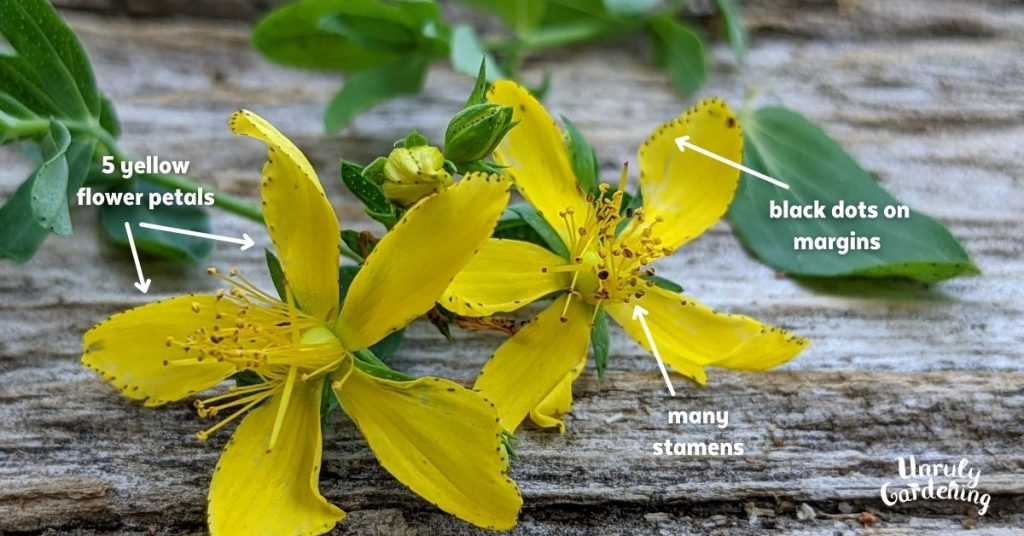
St John’s Wort (Hypericum perforatum) is a perennial herbaceous plant that is native to Europe but can also be found in other parts of the world. It is known for its medicinal properties and its bright yellow flowers that bloom during the summer months.
Climate and Soil Requirements
St John’s Wort is a hardy plant that can tolerate a range of climates, but it prefers moderate temperatures and plenty of sunlight. It can be grown in USDA hardiness zones 3 to 9.
The plant thrives in well-drained soil that is slightly acidic to neutral in pH. It can tolerate a wide range of soil types, including loam, sandy, and clay soils. However, it prefers soil that is rich in organic matter.
Propagation
St John’s Wort can be propagated through seeds, cuttings, or division.
Seeds: The seeds of St John’s Wort should be sown in the early spring or fall. They can be sown directly into the garden bed or started indoors and later transplanted. The seeds need light to germinate, so they should only be lightly covered with soil.
Cuttings: Stem cuttings can be taken in the spring or early summer. The cuttings should be about 4 to 6 inches long and taken from the new growth. Remove the leaves from the lower half of the cutting and place it into a pot filled with well-draining soil. Keep the soil moist until the cutting develops roots.
Division: St John’s Wort can also be divided in the spring or fall. Dig up the plant and carefully separate the roots into smaller clumps. Replant the clumps, making sure they have enough space to grow.
Care and Maintenance
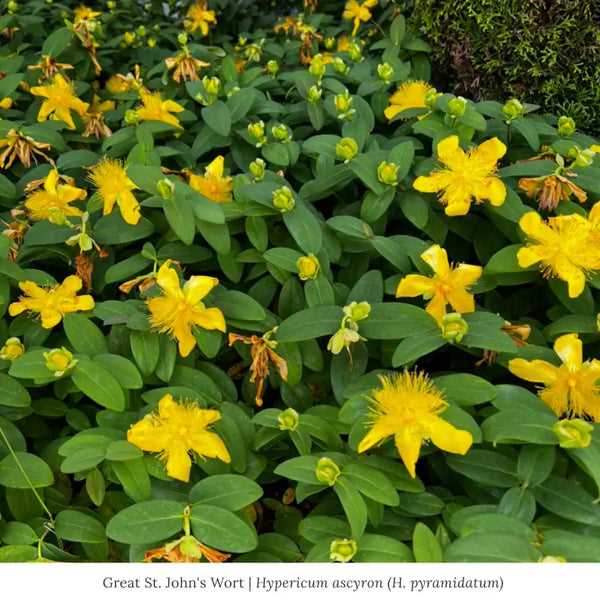
St John’s Wort is a low-maintenance plant, but there are a few things to keep in mind to ensure its optimal growth:
- Watering: Water the plant regularly, especially during dry periods. However, be careful not to overwater, as St John’s Wort prefers slightly dry conditions.
- Fertilizing: St John’s Wort does not require heavy fertilization. A light application of balanced fertilizer in the spring is usually sufficient.
- Pruning: Prune the plant in early spring to remove dead or damaged stems and promote new growth. Avoid pruning too heavily, as it can reduce flowering.
- Weeding: Remove any weeds that may compete with the plant for nutrients and water.
Harvesting and Usage
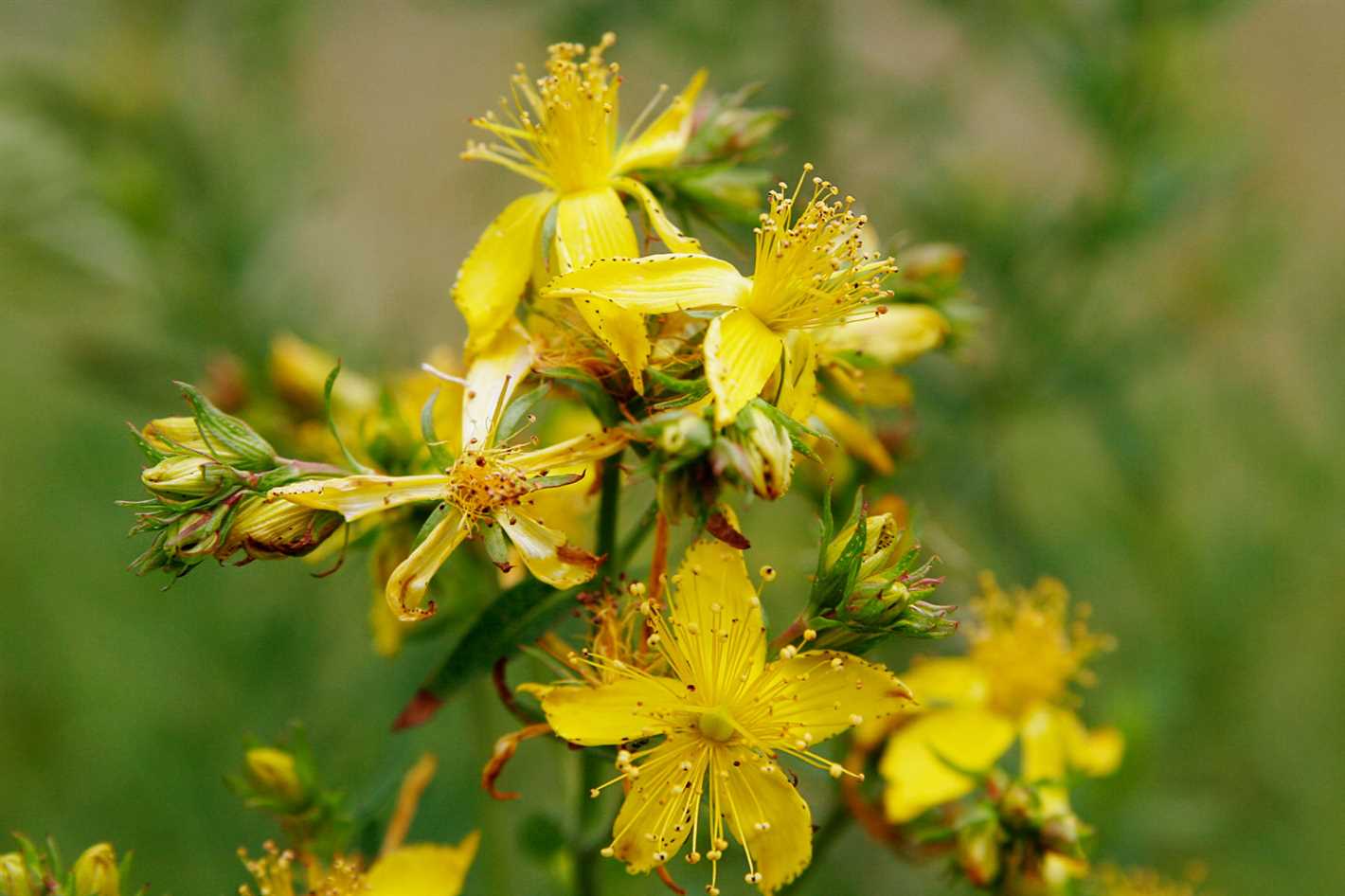
St John’s Wort is typically harvested when the flowers are in full bloom. Cut the flower heads and dry them in a cool, well-ventilated area. Once dried, the flowers can be used to make herbal teas, infused oils, or tinctures.
It is important to note that St John’s Wort may interact with certain medications, so it is advisable to consult a healthcare professional before using it for medicinal purposes.
Planting and Growing Conditions
St. John’s wort is a hardy plant that can thrive in a variety of growing conditions. However, it is important to provide the right environment for optimal growth and production. Here are some key factors to consider when planting and growing St. John’s wort:
Climate
St. John’s wort is native to Europe, but it can also be grown in temperate regions around the world. It prefers a climate with mild summers and cool winters. The plant is known to be tolerant of moderate drought conditions, but it requires a consistent water supply during the growing season.
Soil
St. John’s wort can adapt to various soil types, but it thrives best in well-drained, loamy soil. The pH level of the soil should be slightly acidic to neutral, ranging from 6.0 to 7.0. It is important to prepare the soil before planting by removing any weeds or debris and incorporating organic matter to improve its fertility and moisture retention.
Sunlight
St. John’s wort is a sun-loving plant and requires at least six hours of direct sunlight per day. It is important to choose a planting location that receives ample sunlight. Insufficient sunlight can result in poor growth and reduced flower production.
Spacing
When planting St. John’s wort, it is important to provide adequate space between each plant. This allows for good air circulation and reduces the risk of diseases. The recommended spacing between plants is usually about 18 to 24 inches apart.
Watering
During the establishment phase, St. John’s wort plants require regular watering to promote root development. Once established, they are more drought-tolerant and may only require occasional watering during dry periods. It is important to water the plants deeply to encourage deep root growth.
Fertilizer
St. John’s wort is a relatively low-maintenance plant and does not require heavy fertilization. However, applying a balanced fertilizer in spring can help promote healthy growth and flower production. It is important to follow the manufacturer’s instructions for the type and amount of fertilizer to use.
Pruning
Pruning is an important maintenance practice for St. John’s wort. It is usually done in early spring or late winter before new growth begins. Pruning helps to maintain a compact and bushy shape, encourages flowering, and removes any dead or diseased foliage. It is important to use clean and sharp pruners to prevent the spread of diseases.
By providing the right planting and growing conditions, you can successfully cultivate St. John’s wort and enjoy its beautiful flowers and medicinal properties.
Harvesting and Pruning Techniques
Harvesting and pruning are important techniques in the cultivation of St John’s Wort plants. Proper harvesting and pruning practices can help ensure a healthy and productive plant.
Harvesting Techniques
- Harvest St John’s Wort flowers when they are in full bloom. The flowers should be bright yellow and fully open.
- Cut the flowers with a sharp knife or scissors, leaving a few inches of stem attached.
- Avoid harvesting flowers after rainfall, as this can dilute the medicinal properties.
- Harvest the flowers in the morning, after the dew has dried but before the heat of the day.
- Place the harvested flowers in a clean, dry basket or container to avoid moisture buildup.
Pruning Techniques
- Prune St John’s Wort plants in early spring or early fall.
- Remove any dead or damaged branches by cutting them back to the main stem.
- Thin out the plant by removing any crowded or weak branches.
- Prune back the plant to shape it and encourage bushier growth.
- Use sharp pruning shears to make clean cuts and avoid damaging the plant.
Tips for Harvesting and Pruning St John’s Wort
Here are some additional tips to keep in mind when harvesting and pruning St John’s Wort:
- Wear gloves and long sleeves when harvesting or pruning, as the plant can cause skin irritation in some individuals.
- Check local regulations and guidelines before harvesting St John’s Wort, as some areas have restrictions on wild harvesting.
- Do not harvest all the flowers from a single plant, as this can weaken and stress the plant.
- Store harvested St John’s Wort flowers in a cool, dry place to preserve their medicinal properties.
- Dispose of pruned branches properly to prevent the spread of diseases or pests.
By following these harvesting and pruning techniques, you can ensure the health and productivity of your St John’s Wort plants.
Properties of St John’s Wort
- Antidepressant: St John’s Wort is known for its antidepressant properties. It is believed to increase the levels of serotonin, dopamine, and norepinephrine in the brain, which are important neurotransmitters for regulating mood.
- Anxiolytic: St John’s Wort has also been shown to have anxiolytic effects, meaning it can help reduce anxiety and promote a sense of calmness. This property may be related to its ability to regulate neurotransmitter levels in the brain.
- Anti-inflammatory: St John’s Wort contains compounds that have anti-inflammatory properties. These compounds help reduce inflammation in the body, which is important for maintaining overall health and preventing chronic diseases.
- Antiviral: Some studies have suggested that St John’s Wort has antiviral properties, particularly against certain viruses such as herpes simplex virus. However, more research is needed to fully understand its antiviral effects.
- Antibacterial: St John’s Wort has been shown to have antibacterial properties, making it potentially useful in the treatment of bacterial infections. It may help inhibit the growth of certain bacteria and improve overall immune function.
- Antioxidant: St John’s Wort contains antioxidants that help protect the body against oxidative stress and damage caused by free radicals. These antioxidants may help reduce the risk of chronic diseases such as heart disease and cancer.
- Wound healing: St John’s Wort has been traditionally used for its wound healing properties. It may help promote the healing of minor cuts and burns by reducing inflammation and stimulating tissue regeneration.
- Pain relief: St John’s Wort has analgesic properties, meaning it can help reduce pain. It may be effective in relieving mild to moderate pain, such as headaches, muscle aches, and menstrual cramps.
- Anti-cancer: Some studies have suggested that St John’s Wort may have anti-cancer properties, particularly against certain types of cancer such as breast, prostate, and colon cancer. However, more research is needed to confirm these effects.
Medicinal Uses
Depression and Anxiety
St John’s Wort is commonly used as a natural remedy for depression and anxiety. It is believed to help alleviate these conditions by increasing the levels of serotonin and dopamine in the brain. However, it is important to note that its effectiveness may vary from person to person, and it is recommended to consult a healthcare professional before starting any new herbal treatment.
Sleep Disorders
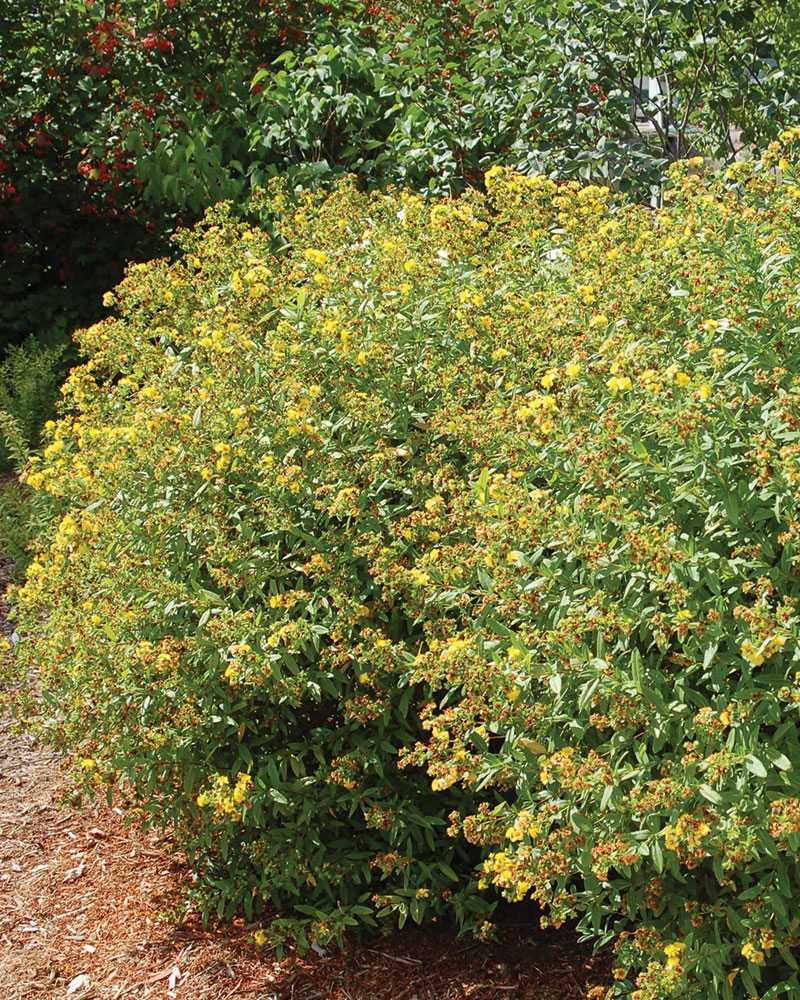
St John’s Wort has also been used to treat sleep disorders such as insomnia. Its mild sedative and calming effects may help improve sleep quality and duration. However, more research is needed to fully understand its impact on sleep disorders and determine the appropriate dosage and duration of treatment.
Wound Healing
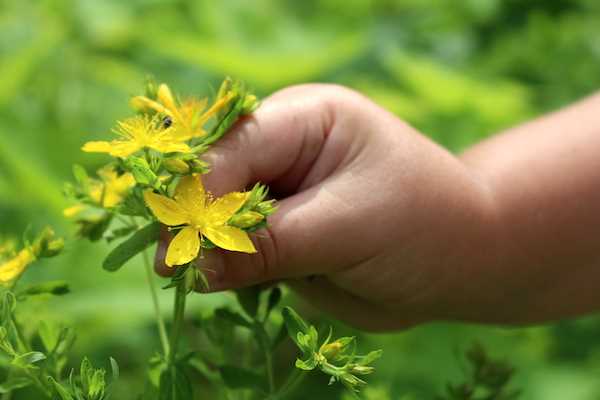
Topical application of St John’s Wort oil or salve has been used to promote wound healing. Its anti-inflammatory and antibacterial properties may help reduce inflammation, prevent infection, and facilitate the healing process. However, it should not be applied to open wounds without the guidance of a healthcare professional.
Nerve Pain
St John’s Wort has been traditionally used to relieve nerve pain, such as sciatica and neuralgia. Its analgesic properties may help reduce pain and inflammation associated with these conditions. However, it is important to consult a healthcare professional for a proper diagnosis and guidance on the use of St John’s Wort for nerve pain.
Menopausal Symptoms
Some women use St John’s Wort to alleviate symptoms associated with menopause, such as hot flashes and mood swings. Its hormonal properties may help regulate hormonal fluctuations and improve overall well-being during this transitional phase. However, it is essential to consult a healthcare professional before using St John’s Wort for menopausal symptoms.
Note:
St John’s Wort may interact with certain medications, including contraceptives, antidepressants, and anticoagulants. It is important to consult a healthcare professional before using St John’s Wort alongside any other medications to avoid potential interactions and side effects. Additionally, pregnant and breastfeeding women should avoid using St John’s Wort due to potential risks.
Aromatherapy Purposes
The use of St John’s Wort in aromatherapy is gaining popularity due to its many therapeutic properties and pleasant scent. The essential oil extracted from the flowers of St John’s Wort can be used in a variety of ways to treat various conditions and promote overall well-being.
Anti-depressant
St John’s Wort essential oil is known for its antidepressant properties. It can help alleviate symptoms of mild to moderate depression by promoting positive emotions and reducing anxiety. The oil can be diffused in a room or applied topically after dilution with a carrier oil.
Skin care
St John’s Wort essential oil has proven benefits for the skin. Its anti-inflammatory and antimicrobial properties make it effective in treating skin conditions like acne, eczema, and minor wounds. The oil can be added to creams, lotions, or diluted in a carrier oil for topical application.
Pain relief
The analgesic properties of St John’s Wort essential oil make it a popular choice for relieving muscle and joint pain. It can be used in massage oils, bath salts, or added to a warm compress for local pain relief.
Relaxation and sleep
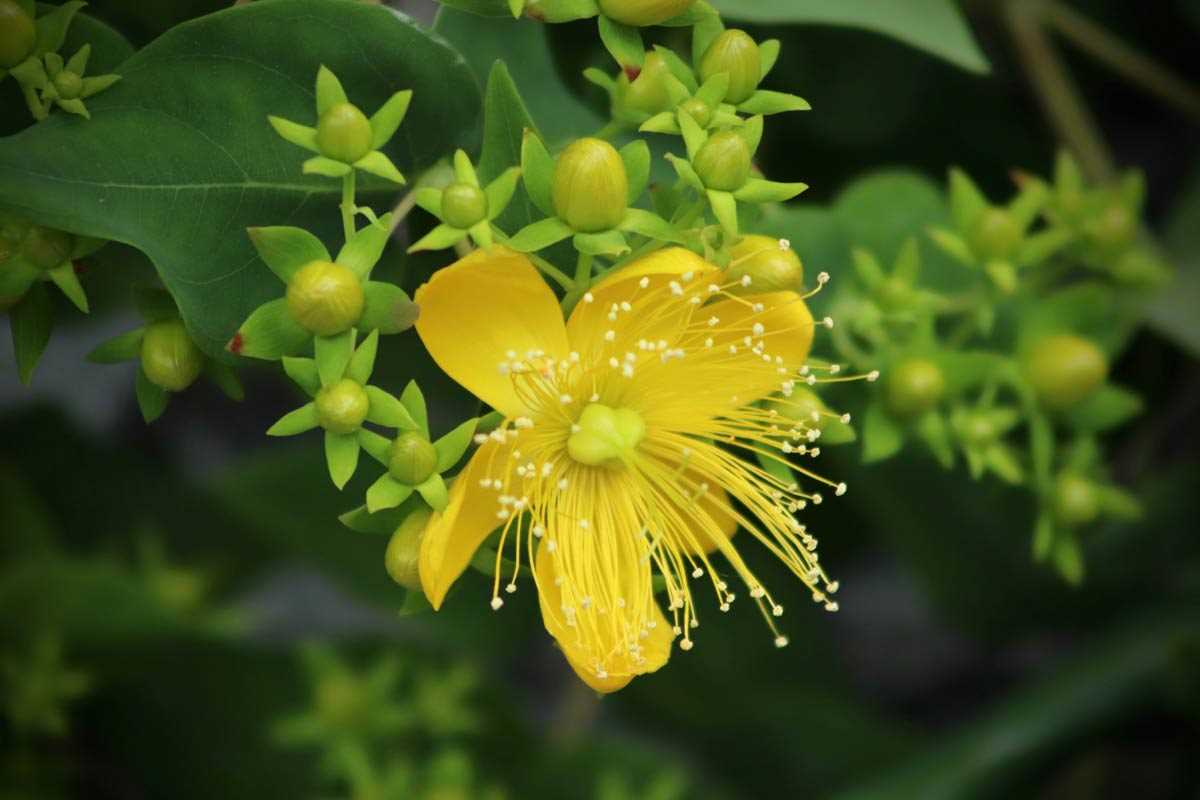
The soothing aroma of St John’s Wort essential oil is known to promote relaxation and improve sleep quality. It can be used in diffusers, added to a warm bath, or applied topically to the temples and wrists before bed.
Anti-inflammatory
St John’s Wort essential oil possesses anti-inflammatory properties that can help reduce swelling and inflammation. It can be used to relieve insect bites, bruises, and arthritis pain. Dilute the oil with a carrier oil and apply it directly to the affected area.
Caution:
- Always dilute St John’s Wort essential oil with a carrier oil before use, as it can cause skin irritation in its undiluted form.
- Avoid direct sunlight after applying St John’s Wort essential oil topically, as it can cause phototoxic reactions.
- Consult a healthcare professional before using St John’s Wort essential oil if you are pregnant, breastfeeding, or taking any medications.
Species and Varieties of St John’s Wort
Hypericum perforatum
Hypericum perforatum, also known as common St. John’s Wort or perforate St. John’s Wort, is the most well-known and widely cultivated species of St. John’s Wort. It is a perennial herb native to Europe and has naturalized in many parts of the world. This species is known for its medicinal properties and its use in traditional herbal medicine.
Hypericum calycinum
Hypericum calycinum, commonly known as Rose of Sharon or Aaron’s beard, is another popular species of St. John’s Wort. Unlike Hypericum perforatum, which is a herbaceous perennial, Hypericum calycinum is a semi-evergreen shrub. It is native to Southeastern Europe and Western Asia and is widely grown as an ornamental plant for its attractive yellow flowers.
While Hypericum calycinum does not have the same medicinal properties as Hypericum perforatum, it is still valued for its beauty and ability to tolerate a wide range of growing conditions. It is often used in landscaping and ground cover applications.
Hypericum kalmianum

Hypericum kalmianum, commonly known as Kalm’s St. John’s Wort, is a native North American species. It is a deciduous shrub that typically grows to a height of 1-2 feet. Like other species of St. John’s Wort, Hypericum kalmianum produces bright yellow flowers.
Hypericum kalmianum ‘Blue Velvet’: This variety has blue-green foliage and deep blue flowers, providing a unique twist on the traditional yellow blooms of St. John’s Wort.
Hypericum kalmianum ‘Gemo’: This variety has a compact growth habit and produces an abundance of flowers throughout the summer months.
Hypericum olympicum
Hypericum olympicum, also known as showy St. John’s Wort, is a species native to the Mediterranean region. It is a perennial herb that forms clumps and produces bright yellow flowers from late spring to early summer. This species is well-suited to rock gardens and other dry, sunny areas.
| Variety | Description |
|---|---|
| Hypericum olympicum ‘Citrinum’ | This variety has lemon-yellow flowers and silver-gray foliage, adding a touch of brightness to any garden. |
| Hypericum olympicum ‘Nanus’ | This variety is a dwarf form of Hypericum olympicum, reaching a height of only 6-8 inches. |
Common Species and Their Characteristics
Hypericum perforatum
Hypericum perforatum, commonly known as St. John’s Wort, is the most well-known species of the Hypericum genus. It is a perennial herbaceous plant that can grow up to 1 meter in height. The leaves are oblong and opposite, and it produces bright yellow flowers with five petals. St. John’s Wort is known for its medicinal properties and is often used as a natural remedy for depression and anxiety.
Hypericum calycinum
Hypericum calycinum, also known as Rose of Sharon or Aaron’s Beard, is a species of creeping shrub that is native to southeastern Europe and southwestern Asia. It has oval, dark green leaves and produces large, golden yellow flowers with five petals. This species is commonly used as a ground cover and is prized for its ability to tolerate a wide range of soil and light conditions.
Hypericum androsaemum
Hypericum androsaemum, commonly known as Tutsan or Sweet Amber, is a deciduous shrub that is native to Europe and western Asia. It can reach a height of 1.5 meters and has dark green obovate leaves. The flowers are small and yellow, and it produces red berries in the autumn. Tutsan is often used in herbal medicine for its diuretic and antiseptic properties.
Hypericum hirsutum
Hypericum hirsutum, also known as Hairy St John’s Wort, is a perennial plant that is native to Europe and western Asia. It has hairy, lance-shaped leaves and produces bright yellow flowers. This species is often found in damp meadows and woodland edges. Hairy St John’s Wort is used in traditional medicine as a treatment for stomach ailments and dysentery.
Rare and Endangered Varieties
While St John’s Wort is generally a common and widespread plant, there are certain varieties that are considered rare or endangered. These varieties often have unique characteristics or grow in specific habitats that make them more vulnerable to extinction.
Golden St John’s Wort (Hypericum frondosum)
- Description: The Golden St John’s Wort is a rare variety known for its bright yellow flowers and dense foliage. It typically grows in dry, rocky areas and is more tolerant of drought compared to other varieties.
- Habitat: This variety is primarily found in the southeastern United States, particularly in Alabama, Georgia, and South Carolina.
- Status: The Golden St John’s Wort is currently listed as rare and threatened in several states due to habitat loss and invasive plant species.
Appalachian St John’s Wort (Hypericum kalmianum)
- Description: The Appalachian St John’s Wort is a small shrub with clusters of bright yellow flowers. It is known for its ability to grow in rocky, mountainous regions.
- Habitat: This variety is native to the Appalachian Mountains in the eastern United States, including areas in Virginia, West Virginia, and North Carolina.
- Status: The Appalachian St John’s Wort is considered endangered in several states due to habitat destruction caused by logging and development.
Canary Islands St John’s Wort (Hypericum reflexum)
- Description: The Canary Islands St John’s Wort is a unique variety with narrow, elongated leaves and yellow flowers. It is adapted to the dry and arid conditions of the Canary Islands.
- Habitat: This variety is found exclusively in the Canary Islands, particularly on rocky slopes and cliffs.
- Status: The Canary Islands St John’s Wort is listed as critically endangered due to habitat destruction caused by agriculture, urbanization, and invasive plant species.
Efforts are being made to conserve and protect these rare and endangered varieties of St John’s Wort through habitat conservation, restoration, and seed banking. It is important to raise awareness about their importance and promote sustainable cultivation practices to ensure their survival for future generations.
Questions and Answers:
What is St John’s Wort?
St John’s Wort is a flowering plant native to Europe, Asia, and North Africa. It is known for its medicinal properties and has been used for centuries in traditional medicine.
What are the cultivation requirements for St John’s Wort?
St John’s Wort requires well-drained soil and full sunlight for optimal growth. It is a hardy plant that can tolerate drought conditions but prefers regular watering.
What are the properties of St John’s Wort?
St John’s Wort has numerous properties, including antidepressant, antiviral, and anti-inflammatory effects. It is commonly used to treat mild to moderate depression and has been found to be as effective as prescription antidepressants in some cases.
How many species of St John’s Wort are there?
There are over 400 species of St John’s Wort, but the most commonly cultivated and used for medicinal purposes is Hypericum perforatum.
What are some popular varieties of St John’s Wort?
Some popular varieties of St John’s Wort include ‘Hidcote’, ‘Rowallane’, ‘Hypericum inodorum’, and ‘Helene’.
Can St John’s Wort interact with other medications?
Yes, St John’s Wort can interact with certain medications, including birth control pills, antidepressants, and blood thinners. It is important to consult with a healthcare professional before taking St John’s Wort if you are taking any other medications.
Are there any side effects of taking St John’s Wort?
Some common side effects of taking St John’s Wort include dizziness, dry mouth, and sensitivity to sunlight. It may also cause interactions with certain medications, so it is important to talk to a healthcare professional before taking it.







